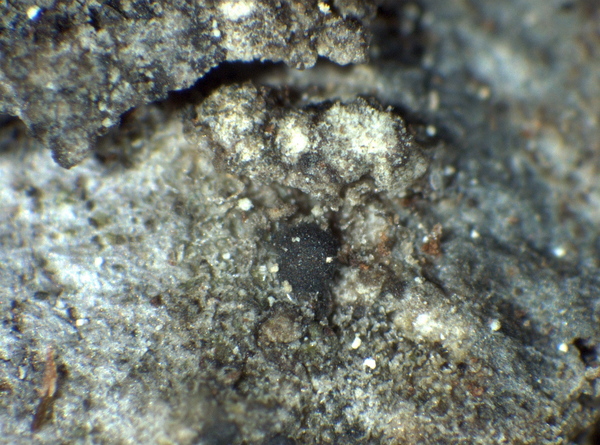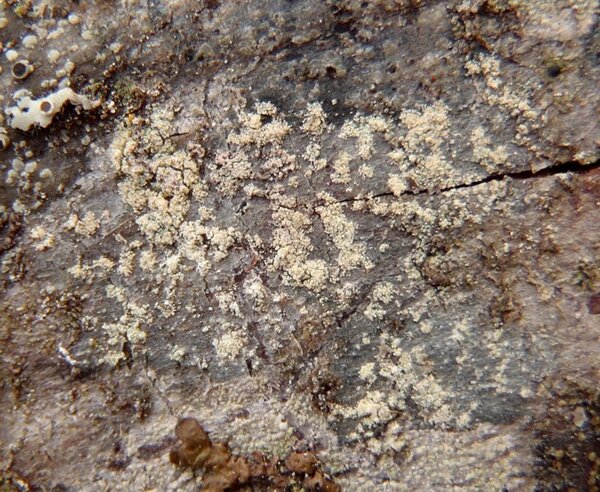Frutidella furfuracea (Anzi) M. Westb. & M. Svensson
Mycokeys, 25: 64, 2017. Basionym: Biatora furfuracea Anzi - Comm. Soc. Crittog. Ital. 2: 13, 1864.
Synonyms: Biatora amaurospoda Anzi; Biatora pullata Norman; Frutidella pullata (Norman) Schmull; Lecidea anziana Zahlbr.; Lecidea furfuracea (Anzi) Jatta non Pers.; Lecidea ostrogothensis Nyl.; Lecidea perobscurans Nyl.; Lecidea pullata (Norman) Th. Fr.
Distribution: N - Frl (Nascimbene & al. 2021), Ven (Lazzarin 1997, Thor & Nascimbene 2007), TAA (Thor & Nascimbene 2007, Nascimbene & al. 2007b, 2022, Nascimbene 2014, Nascimbene & Marini 2015, Nimis & al. 2015, Trindade & al. 2021), Lomb (Printzen 1995), Piem (Isocrono & al. 2004). C - Tosc (Benesperi & al. 2007).
Description: Thallus crustose, endo- to episubstratic in non-sorediate parts, continuous to more or less distinctly areolate, forming regular or irregular, up to 10 cm wide patches, usually delimited by a dark, bluish to brown prothallus, the blue pigment N+ red. Areoles 0.1-0.3 mm wide, convex, green to pale brown, soon bursting apically into minute, irregularly punctiform, 0.1(-0.3) mm wide, mostly flat soralia which rarely coalesce into a subleprose crust; soredia farinose, up to 20-30 μm in diam, the external ones brownish, the internal ones pale greenish. Apothecia not always present, biatorine, up to 0.6 mm across, the disc flat to strongly convex, blackish but often faintly pruinose and appearing bluish grey, lead-grey or grey-black, rarely with a brownish hue, the proper margin soon excluded. Proper exciple more or less colourless, of radiating hyphae; epithecium pale olive-green to greenish brown; hymenium colourless to bluish green in upper part; paraphyses strongly coherent, sparingly branched and anastomosing; hypothecium pale olive-brown. Asci 8-spored, clavate, the K/I+ blue tholus penetrated by a faintly amyloid apical cushion with parallel or diverging flanks, the wall K/I-, surrounded by a K/I+ blue outer layer, Lecanora-type. Ascospores 1-celled, hyaline, ellipsoid, 9-17 x 4-7.5 µm. Photobiont chlorococcoid. Spot tests: thallus and soralia K- (or soralia K+ very pale yellow), C-, KC-, P-, UV+ white. Chemistry: sphaerophorin (major), isosphaeric acid (traces).
Note: on bark, on basal parts of (mainly) coniferous trees, more rarely on lignum, often associated with Parmeliopsis ambigua, with optimum in the subalpine belt; most frequent in the Alps.
Growth form: Crustose
Substrata: bark and lignum
Photobiont: green algae other than Trentepohlia
Reproductive strategy: mainly asexual, by soredia, or soredia-like structures (e.g. blastidia)
Commonnes-rarity: (info)
Alpine belt: absent
Subalpine belt: rather common
Oromediterranean belt: absent
Montane belt: rather rare
Submediterranean belt: absent
Padanian area: absent
Humid submediterranean belt: absent
Humid mediterranean belt: absent
Dry mediterranean belt: absent

Predictive model
Herbarium samples
Growth form: Crustose
Substrata: bark and lignum
Photobiont: green algae other than Trentepohlia
Reproductive strategy: mainly asexual, by soredia, or soredia-like structures (e.g. blastidia)
Commonnes-rarity: (info)
Alpine belt: absent
Subalpine belt: rather common
Oromediterranean belt: absent
Montane belt: rather rare
Submediterranean belt: absent
Padanian area: absent
Humid submediterranean belt: absent
Humid mediterranean belt: absent
Dry mediterranean belt: absent

Predictive model
| Herbarium samples |
 INDEX FUNGORUM
INDEX FUNGORUM
 GBIF
GBIF
 DOLICHENS
DOLICHENS




